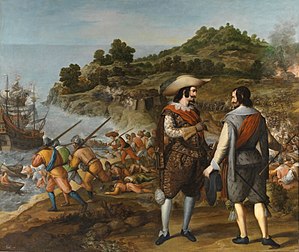Battle of San Juan (1625)
| Battle of San Juan (1625) | |||||||
|---|---|---|---|---|---|---|---|
| Part of the Eighty Years' War | |||||||
 Seventeenth-century Spanish painting commemorating Hendricksz's defeat at San Juan de Puerto Rico. By Eugenio Caxés, Museo del Prado. |
|||||||
|
|||||||
| Belligerents | |||||||
|
|
|
||||||
| Commanders and leaders | |||||||
|
|
|
||||||
The Battle of San Juan was fought on 29 September 1625, and was an engagement of the Eighty Years' War. A Dutch expedition under the command of Boudewijn Hendricksz attacked the island of Puerto Rico, but despite besieging San Juan for several months, was unable to capture it from Spain.
On 24 September 1625, 17 Dutch ships arrive at San Juan de Puerto Rico, whose Spanish governor — naval and military veteran Juan de Haro y Sanvitores - had been in office less than a month. Nevertheless, he prepared to receive the enemy as best he could preparing El Morro's battery to close the main entrance to the San Juan Bay, and sending his predecessor, Juan de Vargas, to nearby Boquerón with militia to hinder any landings in Escambrón Inlet.
Hendricksz implemented a bold plan. At 1:00 P.M. the next day the entire Dutch fleet sailed directly into San Juan’s harbor:
Roode Leeuw, Witte Leeuw, Leyden, Blauwe Leeuw, Goude Valck, Utrecht, Nieuw Nederlandt, Hoop van Dordrecht, Kleyne Tijger, Hoorn, Medemblik, Gouden Molen, Vlissingen, West Kappel, Goude Sonne, Koningin Hester, and Jonas.
They exchanged shots with the harbor castle, inflicting superficial damage and killing four Spaniards, before gaining a safe anchorage within the roadstead off Puntilla Point, beyond range of de Haro’s artillery. However, shoals prevented an immediate disembarkation of troops. The delay allowed Spanish civilians to flee inland, while the governor marshaled his slender strength within San Felipe del Morro citadel. He installed six additional bronze 12-pounders in its embrasures and mustered 330 men, of which 220 were effective. He also had abundant supplies.
On 26 September, Hendricksz led 700–800 men ashore and occupied the empty city. Two days later the Dutch also occupied the small, wooden El Cañuelo fort, which stood on a rock islet in the harbour. The main citadel proved impossible to storm, so the Dutch began digging saplines and installing a six-gun battery atop Calvario Heights by 29 September. At 9:00 A.M. the next day Hendricksz called upon de Haro to surrender. de Haro rejected the offer so action resumed. Capt. Jan Jasperz de Laet of West Kappel exited the harbour on 1 October to chase away a Spanish ship arriving with supplies. On the night of Friday, 3–4 October, the Spaniards sallied out of their citadel in two companies of 40 men apiece under Capts. Sebastián de Avila and Andrés Botello, but accomplished little.
...
Wikipedia
